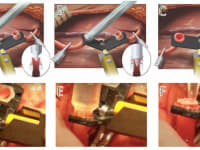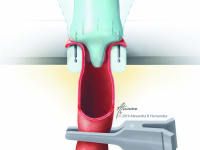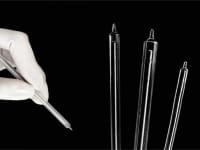

Problem: Microvascular anastomosis is the surgical coaptation of small (sub-centimeter) veins and arteries with the aid of loupe or microscope magnification. Microvascular anastomosis of veins is readily accomplished using a microanastomotic coupling device (Synovis GEM Coupler) which reduces complication rates, improves patency rates, and substantially reduces the time necessary to complete the coaptation compared to manual suturing. Arterial microvascular anastomoses, however, are currently accomplished with standard manual suturing techniques because the thick, muscular wall of the arteries precludes use of the microanastomotic coupler; the thick wall of the artery prevents them from being stretched over the rings of a coupler. As a result, arterial microanastomoses performed by manual suturing takes ~25 minutes in the operating room, versus ~5 minutes using a coupling device (for veins). The large amount of time and multiple sutures required for an arterial anastomosis ends up costing $1457 per anastomosis on average and increases the risks to the patient due to a longer time under anesthesia.
Innovation: A novel tool set to help facilitate arterial microvascular anastomosis has been designed, manufactured, and validated in a live porcine model. The tool, referred to as the Arterial Everter, is used in conjunction with the Synovis GEM Coupler to replace traditional vessel suturing and enable rapid anastomosis of arteries ranging from 1.5-4 mm in diameter. The average time to perform the anastomosis was significantly less when using the everter/coupler compared to manual suturing (6:35 min vs. 25:09 min, p < 0.001). Immediately post-op, 100% patency was observed in both groups. At one week post-op, four of five (80%) of coupled arteries and all five (100%) of hand-sewn arteries were patent. The degree of arterial wall injury, neointimal formation, and luminal stenosis for patent arteries were similar between groups
Manufacturability: The arterial everter was designed for ease of manufacturability. The design consists of a stainless steel rod over-molded with medical grade silicone using traditional injection/compression molding techniques.
Marketability: Target users for this device are plastic surgeons, ENTs, oral surgeons, orthopedic surgeons, and others that perform microsurgeries and reconstructions. In 2014, board certified plastic surgeons alone performed 5.8 million reconstructive procedures in the US. Of these 5.8 million procedures, there were over 175,000 procedures where microanastomosis would be required.
By analyzing the cost savings of sutures and the drastic reduction in operating time, a hospital could expect to yield a savings ~$1000 per anastomosis by using the Arterial Everter. Additionally, our solution enables doctors to perform arterial microanastomoses just as quickly as microanastomoses on veins providing significant time/cost savings over the current suturing techniques. It will also reduce leak rate, risk of vessel injury, vessel kinking, and time under anesthesia for the patient along with being technically easier and faster for the doctor to perform. The use of the coupler rings for arteries also adds a significant clinical value because the blood-flow through the anastomosis can be monitored using the Flow Coupler system which incorporates an ultrasonic Doppler probe into the rings, allowing for live blood flow monitoring postoperatively.
-
Awards
-
 2017 Medical Category Winner
2017 Medical Category Winner -
 2017 Top 100 Entries
2017 Top 100 Entries
Like this entry?
-
About the Entrant
- Name:Jeffrey Plott
- Type of entry:teamTeam members:Jeffrey S. Plott, MS
Adeyiza O. Momoh, MD
Ian C. Sando, MD
Brendan M. McCracken
Mohammed H. Tiba, MD MS
Kevin R. Ward, MD
Jeffrey H. Kozlow, MD, MS
Paul S. Cederna, MD - Software used for this entry:SolidWorks
- Patent status:pending








